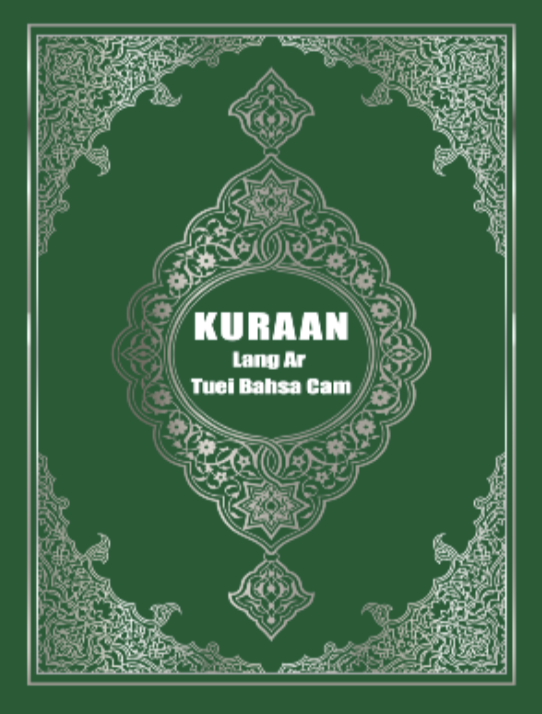A life-long dream becomes a reality
By Sean-Habib Tu
March/April 2023

Translating the Quran into Cham has been my father’s dream for a long time. But why Cham, an obscure Asian language spoken by less than a million people? Because … in addition to conveying its meaning to the faithful, a deeper motive lies beneath the dust of history. Once we dust it off, the answer becomes obvious.
The Cham are the descendants of a kingdom that once ruled the central coastal lands of present-day Vietnam. After the fall of its capital Vijaya in 1471, many Cham migrated to neighboring Cambodia, Indonesia, Malaysia and China’s Hainan Island. When Champa disappeared from the map in 1832, its descendants scattered throughout Southeast Asia. My father and I are just two of the many Cham who made their way to the West after the long war in Southeast Asia finally ended in 1975.
During the 190 years since Champa vanished, the Cham became one of Vietnam’s ethnic and religious minorities: approximately 170,000 individuals surrounded by 92 million Vietnamese and another approximately 750,000 living amidst 8 million Cambodians. Representing less than 1% of Vietnam’s population, the resulting tremendous cultural pressure has led to a new urgency: saving the Cham people’s language and culture before they become no more than memories. And this negative reality inspired my father to act.
This eight-year-long project was quite challenging, due to the lack of authentic vocabulary in Cham to accurately convey the Quran’s meaning, for example, al-bir (righteousness) and taqwa (God-consciousness). These terms are specific to the Quran, so my father decided to leave such terms in their original Arabic. Other words have have been totally forgotten but are being revived, among them paramük (punishment) and firman (he said). Fortunately, the Cham-French dictionary compiled by the famed linguist Étienne-François Aymonier (1844-1929) still exists. This French national, who studied ancient Khmer and ancient Cham during the early 1900s and conducted extensive research, left behind a valuable resource that has preserved our language it its pristine condition.
When the French withdrew from Indochina (i.e., Vietnam, Laos, Cambodia) in 1954 after 100 years of colonialism, they left behind an educational institution that my father attended during his early adulthood. Continuing his education, he graduated from The Institution for The Government in Saigon in the 1960s and worked for the South Vietnamese government as director of logistics under the department’s vice-president until North Vietnam took over in 1975. His background in French enabled him to utilize the dictionary and vitalize the Cham vocabulary during the translating process.
In the third century C.E., Champa adopted a modified Sanskrit script as its official administrative language. As the population increasingly embraced Islam during the fifteenth century, some sectors in the kingdom adopted Jawi, a modified Arabic script widely used in the Malay world. Starting in the 1960s, some Cham intellectuals advocated adopting the Latin alphabet to unify both scripts.
While working to preserve the language and culture, my father collaborated with fellow Cham researcher Po Dharma (1945-2021) to adopt the Latinized Cham script created by the École Française d’Extrême-Orient (The French School of the Far East). The two teams — one in Vietnam and the other in the U.S. — worked with this script for the next eight years, finally completing their translation in early 2021. To link the past with the present, the team in Vietnam placed the modified Sanskrit text on the left-hand page and the Latinized Cham script on the right-hand page in order to display both translations of each verse side by side. The panel of experts then reviewed the script and verified its accuracy and authenticity.
The two teams met regularly on ZALO, a Zoom-like meeting platform widely used in Vietnam, to discuss the project’s progress and timeline, as well as to resolve differences in the Arabic-Cham vocabulary and any raised technical issues. For example, ancient Cham doesn’t have the consonant qa, so the Qur’an became known as Kurün. In addition, all foreign words with an a-ending became pronounced as ü like the first sound in uhm. Thus, Kurün and Fatimüh. Given this reality, the teams agreed to compromise: Quran became Kuraan. The process of incorporating the Sanskrit into the translation alone took over 10 months. We reviewed and edited the final version and repeated the process four times. By early December 2022, the final version was ready for printing as a 575-page paperback — 8.5×11 inches and 1.375-inch thick — including a glossary and indexes.
The team members in Vietnam
- Prof. Văn Món Sakaya (Cham Vietnamese): M.A., The University of Malaya, Malaysia; Ph.D., the University of Social Sciences and Humanities, National University, Ho Chi Minh City. He has authored 20+ books and publications, among them “Cham Culture and Literature (HCM City, 2016); “The Values of Champa Ceramics in Asia,” Journal of Viet Nam Hoc, Vol.1, No.2 (Taiwan, 2020); and “Cham-Vietnamese-English-Japanese Vocabulary” (Tokyo, 2014). He currently teaches cultural anthropology at the National University and studies Cham culture, society and language.
- Dr. Phú Văn Hẳn (Cham Vietnamese): M.A., The University of Malaya, Malaysia; Ph.D. from the Department of Education, Ministry of Education and Training, Vietnam. He has authored 15+ books and publications, among them “40 Years of Research on Cham Language and Culture” (HCM City, 2015); “The Cultures of Ethnic Minorities in Southwest Vietnam (HCM City, 2017); “Teaching and Learning Cham (An Giang, 2019); “Vietnamese-Cham, Cham-Vietnamese Dictionary” (HCM City, 2020); and “Cham Progress and Assimilation in Society” (HCM City, 2021).
- Dr. Basiron bin Abdullah (Cham Vietnamese): B.A., Arabic language, Islamic University of Medina; M.A. and Ph.D., the International Islamic University Malaysia. He has been a panelist on the Cham-Malayu Conference (2005), the King Abdul Aziz Foundation’s Conference on the “The Document of the Hajj to Makkah in Southeast Asia Region” (2009), and the Mercy International Foundation of Cambodia’s Conference on “Islam and Medicine” (2015). He is currently the managing director of Halal Authority Co., Ltd. and teaches Arabic at the University of Social Sciences and Humanities, National University, Ho Chi Minh City.
The team members in the U.S.
- Hassan Poklaun (Cham American): B.A., The Institution for The Government, 1968. He was the director of logistics under the department of the vice-president (1971-1975) and migrated to the U.S. in 1981. He has translated the Quran into Vietnamese (1995) and Cham (2021).
- Sean-Habib Tu (Cham American): Migrated to the US in 1981; B.S., electrical engineering, Iowa State University, 1988. He has served as secretary-general of the International Office of Champa, a non-profit organization that promotes Champa’s culture and literature (2014-17); president of the Islamic Center of Santa Ana (2017-21); executive director, Tu Sach Islam, a nonprofit 501.c.3 organization that promotes the translation and dissemination of Islamic literature in Vietnam. He has translated 15+ Islamic books from English into Vietnamese, all of which are posted on www.tusachislam.com. He facilitated the meetings, monitored the timeline, and worked with the printing shop.
- Qasim Tu (Cham American): B.S., civil engineering, University of Transportation and Communication, Thu Duc, Vietnam, 1994, and A.S., design/drafting, Santa Ana College, 2001. He has been chief editor of the web-blog e-Harak Cam (2014); director, Organizing Committee on the Conference of Champa, San Jose, CA (2017), and editor, Champaka, Vol.15 (2020). He helped edit and typeset the Cham Quran translation.
The two teams are currently working on a new project: printing the Quran’s Arabic text along with the Latinized Cham text. Scheduled to be completed by mid-2023, is printed in an easy-to-carry smaller size.
It’s been over nine years since my father embarked on this project. We thank Allah, subhanahu wa ta‘ala, for giving us the opportunity to work on this life-time project. It’s been a humbling experience. Once the Arabic-Latinized Cham translation if finished, we will be able to breathe easier.
Sean-Habib Tu (BSEE, Iowa State University, 1988) has worked with Santa Ana’s Muslim community since 1994. A trained engineer by profession, he has found his passion in community service.
Tell us what you thought by joining our Facebook community. You can also send comments and story pitches to horizons@isna.net. Islamic Horizons does not publish unsolicited material.
